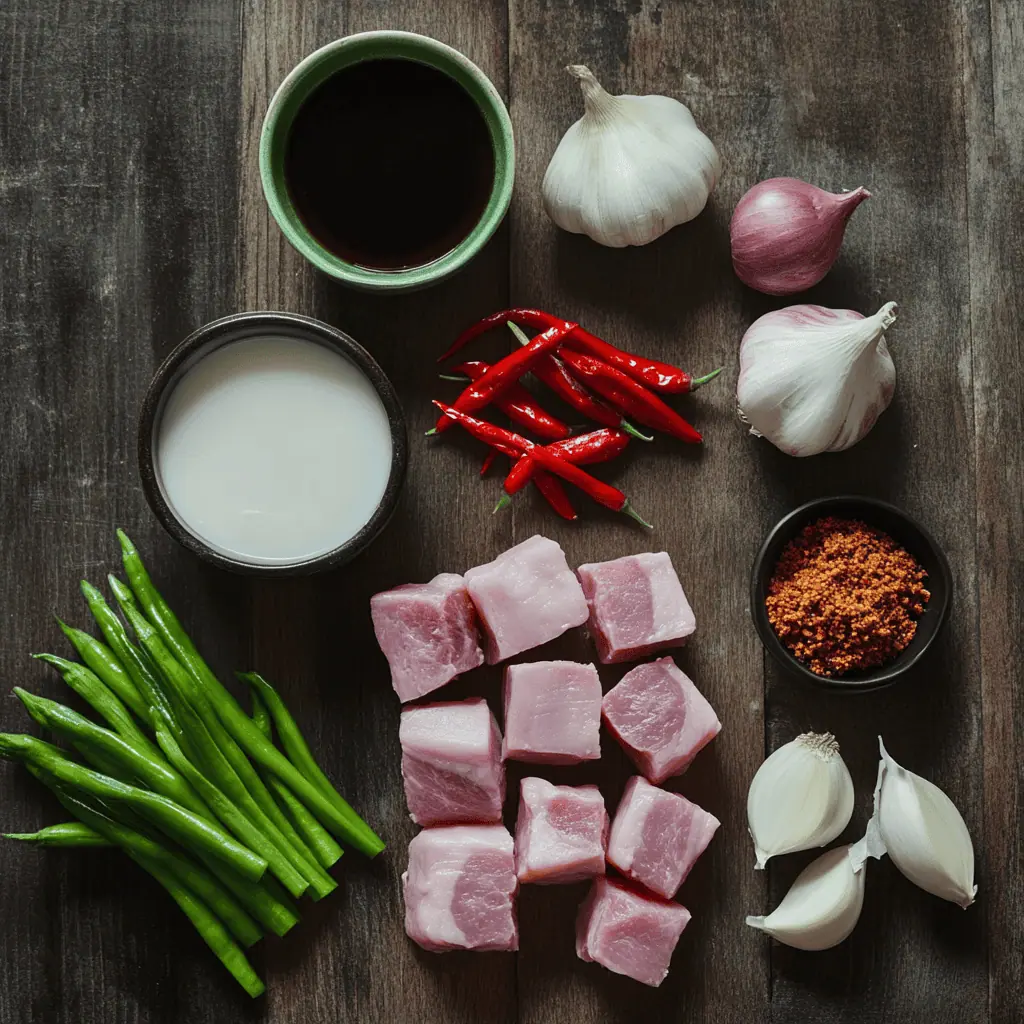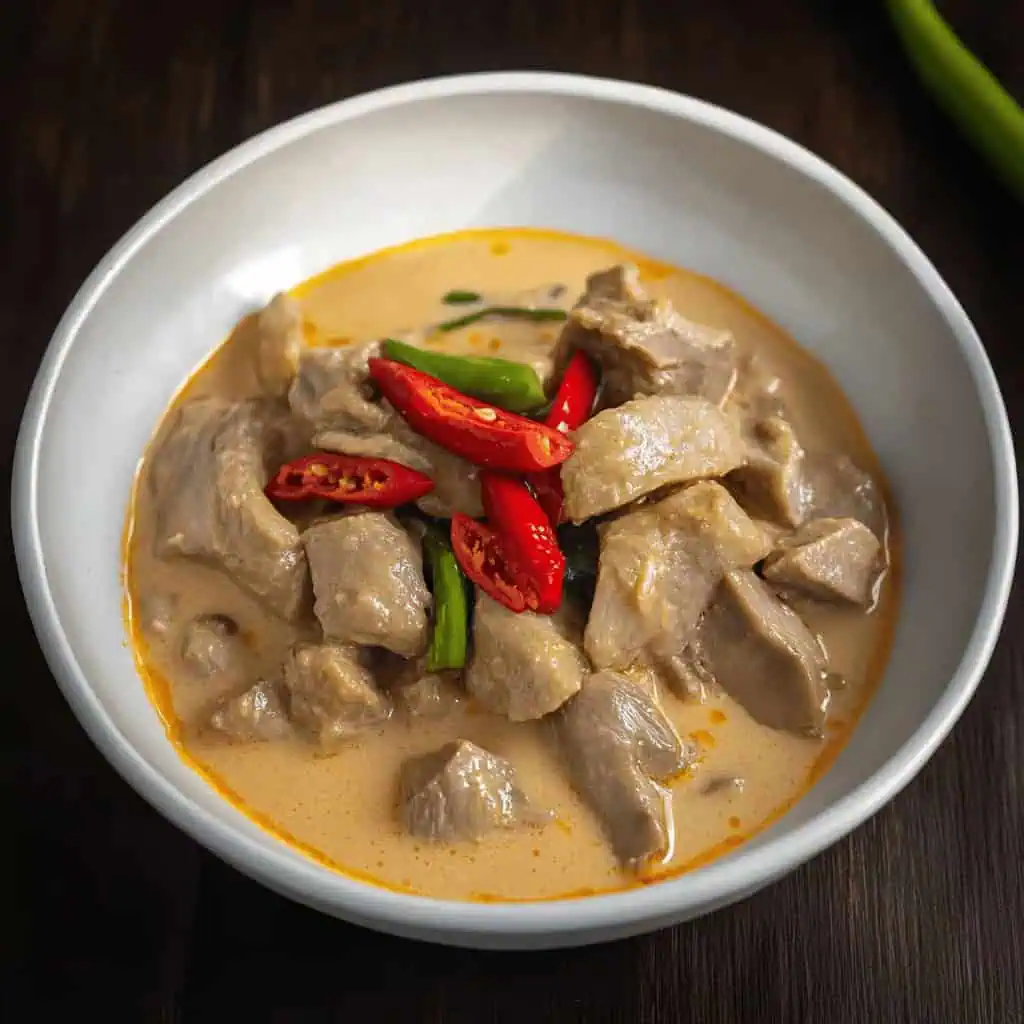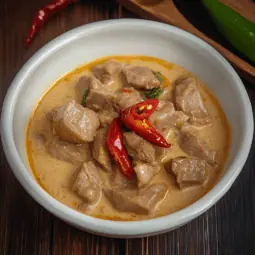Growing up in a family that considered black pepper "spicy," I never thought I'd become someone who'd crave the fiery heat of authentic Bicol Express. But this legendary Filipino dish changed everything for me!
I still remember my first taste at my Bicolana friend's house, tears streaming down my face but unable to stop eating because the creamy coconut milk and tender liempo kept calling me back for more.
That day, between gulps of ice water and countless cups of rice, I discovered that true Bicol Express isn't just about the heat, it's about how the rich gata (coconut milk) dances with the siling labuyo, creating this addictively creamy sauce that's become my ultimate comfort food.
After years of perfecting this Bicol express recipe and building my spice tolerance, I'm excited to share my family's version of this iconic dish.
Jump to:

Why You'll Love This Recipe
- Authentic Bicolano flavors passed down through generations
- Perfect balance of creamy gata and spicy chilies
- Fork-tender pork belly in luxurious coconut sauce
- Customizable spice level while maintaining traditional taste
- Creates that coveted orange oil separation (langis) on top
- Complete with Lola's tips for guaranteed success
Ingredients
Each component in Bicol Express plays a crucial role in creating its distinctive flavor profile. Fatty pork belly provides richness and becomes melt-in-your-mouth tender during slow cooking.
The combination of coconut milk and cream creates the signature velvety sauce, while two types of chilies deliver complex heat rather than just spiciness. Fresh shrimp paste adds that essential umami depth that can't be replicated with any other ingredient.
When these elements come together over gentle heat, they create the perfect harmony of creaminess, spice, and savory flavors that defines authentic Bicol Express.

- 2 pounds pork belly (liempo), cut into 1-inch cubes
- 1 can (13.5 oz) coconut milk (gata)
- 1 cup coconut cream (kakang gata)
- 14 Thai red chilies (siling labuyo), minced
- 2 cups finger chilies (siling haba), sliced
- 2 tablespoons fresh shrimp paste (bagoong alamang)
- 1 medium onion (sibuyas), finely sliced
- 4 cloves garlic (bawang), minced
- 1 tablespoon cooking oil
- 1 cup water
- Salt and pepper to taste
Equipment
- Kawali (Filipino Wok) or Heavy-Bottom Pan - Ensures even heat distribution and prevents burning of the coconut milk
- Sharp Chef's Knife - For cutting pork belly into uniform pieces
- Kitchen Gloves - Protects hands when handling hot chilies
- Wooden Spoon - Best for stirring coconut milk-based dishes without scratching your pan
- Measuring Cups and Spoons - For accurate ingredient proportions
- Cutting Board - Preferably with juice groove for handling meat
- Meat Thermometer - Optional but helpful to check pork doneness
- Airtight Container - For storing leftovers

How to Make
- Preparation: Gather all ingredients and equipment. Prepare your heavy-bottom pan (kawali) and measuring tools.
- Handle Pork: Put on kitchen gloves to protect your hands. Clean the pork belly and cut it into 1-inch cubes. Set aside.
- Prepare Aromatics: Peel and slice one medium onion into thin pieces. Peel four cloves of garlic and mince them finely.
- Prepare Chilies: Carefully prepare the chilies. Remove the stems from both the Thai chilies and finger chilies. Mince the Thai chilies and slice the finger chilies into rings. Keep them separate.
- Start Cooking: Place your pan over medium heat (350°F). Pour in one tablespoon of cooking oil. Wait for the oil to become hot – you'll see it shimmer slightly.
- Sauté Aromatics: Add your sliced onions to the hot oil. Cook while stirring occasionally until they become translucent and soft, about 3-4 minutes. Add the minced garlic and cook until fragrant, about 1 minute. Don't let the garlic brown or it will become bitter.
- Cook Pork: Increase the heat to medium-high (375°F). Add your cubed pork belly to the pan. Cook while stirring occasionally until all sides turn golden brown, about 5-7 minutes.
- Add Shrimp Paste: Lower the heat back to medium (350°F). Add the fresh shrimp paste. Stir well to coat the meat evenly.
- Add Coconut Milk: Pour in the coconut milk and water. Stir gently to combine all ingredients. Lower the heat to low (300°F).
- Simmer: Cover the pan and let it simmer gently. Cook for 40-45 minutes, stirring occasionally, until the pork becomes tender. You should be able to easily pierce it with a fork.
- Add Chilies: Once the pork is tender, add both types of prepared chilies. Stir gently to incorporate them into the sauce.
- Add Coconut Cream: Pour in the coconut cream. Reduce heat to very low (275°F) and simmer uncovered. Cook for 15-20 minutes, stirring occasionally, until the sauce thickens and you see orange oil floating on top.
- Season: Taste the sauce and add salt and pepper as needed. Let it simmer for 2-3 more minutes to incorporate the seasonings.
- Rest: Turn off the heat and let the dish rest for 5 minutes before serving. This allows the flavors to settle and the sauce to achieve the perfect consistency.
- Serve: Serve hot over steaming white rice. For the best experience, prepare some fresh cucumber slices on the side to help cool your mouth between bites.

Tips from Lola's Kitchen
- Use Fresh Ingredients: Always use fresh, not bottled, shrimp paste for authentic flavor. The same goes for chilies - fresh delivers the best heat and aroma.
- Patience is Key: Don't rush the cooking process - slow simmering develops incredible depth of flavor and tenderness in the pork.
- The Oil Separation Test: Look for the signature oil separation (mantika) on top - this orange oil is the mark of properly made Bicol Express.
- Choose Quality Pork: Select pork belly with a good meat-to-fat ratio (about 60% meat, 40% fat) for the best texture and flavor.
- Toast the Bagoong: For deeper umami flavor, lightly toast the shrimp paste before adding the pork.
- Control the Heat: Remove seeds from chilies for less heat while maintaining flavor, or keep them in for authentic fiery heat.
- Coconut Milk Care: Never let coconut milk boil rapidly - this causes separation and graininess. Keep at a gentle simmer.
- Stir Correctly: When stirring, do so gently and in one direction to prevent the coconut milk from breaking.
- Taste as You Go: The spice level builds as it cooks, so taste frequently during the last 15 minutes.
- Counteract Heat: If it becomes too spicy during cooking, add a little more coconut cream to balance it out.
Substitutions
- Pork Belly: Pork shoulder or chicken thighs can work, though the dish will be less rich without the fat from pork belly.
- Fresh Chilies: Dried chilies (rehydrated in warm water for 20 minutes) can substitute in a pinch, use about half the amount.
- Fresh Shrimp Paste: Bottled bagoong can work - rinse it first to remove excess salt, then adjust final seasoning.
- Coconut Cream: Extra thick coconut milk can substitute, or simmer regular coconut milk until reduced and thickened.
- Thai Chilies: Serrano peppers can substitute for siling labuyo, though they're slightly less spicy.
- Finger Chilies: Long green chilies or mild banana peppers can substitute for siling haba.
Troubleshooting
Curdled Coconut Milk
- Problem: Sauce looks grainy or separated
- Solution:
- Never boil coconut milk - keep at a gentle simmer
- Use medium-low heat throughout cooking
- Stir regularly but gently
- Add coconut cream off the heat if separation has already occurred
Too Spicy
- Problem: Overwhelming heat that masks other flavors
- Solution:
- Remove seeds from chilies before adding
- Reduce chili quantity by half
- Add extra coconut cream to mellow the heat
- Serve with extra rice, cucumber slices, and even a glass of milk
Tough Meat
- Problem: Pork isn't tender after recommended cooking time
- Solution:
- Extend cooking time by 15-20 minute increments
- Cut meat into smaller, more uniform cubes
- Maintain a consistent gentle simmer
- Check that your heat isn't too high or too low
Watery Sauce
- Problem: Sauce isn't thick enough
- Solution:
- Simmer uncovered for longer to reduce
- Add more coconut cream
- If needed, remove meat temporarily and reduce sauce alone
Too Salty
- Problem: Overwhelmingly salty flavor
- Solution:
- Add more coconut cream and a squeeze of calamansi or lime juice
- Add a small amount of sugar to balance (½ teaspoon at a time)
- Serve with extra rice to balance the saltiness
Storage & Reheating
Refrigerator Storage
- Store in an airtight container once completely cooled
- Keeps for up to 3 days in the refrigerator
- The flavors often deepen after a day, making leftovers extra delicious
Freezer Storage
- Can be frozen for up to 2 months in freezer-safe containers
- Leave a little space at the top for expansion
- Label with date and contents
- Thaw overnight in the refrigerator before reheating
Reheating Methods
Stovetop (Preferred Method)
- Place in a heavy-bottom pan
- Heat on medium-low, stirring gently
- Add a splash of coconut milk if sauce has thickened too much
- Heat until internal temperature reaches 165°F
Microwave (Quick Method)
- Place in a microwave-safe container
- Heat on 70% power in 2-minute intervals
- Stir between intervals to distribute heat evenly
- Add a splash of coconut milk if needed

FAQ
Is Bicol Express always supposed to be extremely spicy?
Yes, traditionally Bicol Express is known for its intense heat. The authentic version uses more chilies than meat. However, you can adjust the spice level to your preference while maintaining the essential flavor profile.
Can I make this less spicy but still authentic?
While you can reduce the chilies, traditionally it should be quite spicy. For a milder version with similar flavors, try Binagoongan sa Gata instead, which uses the same base but fewer chilies.
Why isn't my sauce separating to show that orange oil on top?
Oil separation requires patience and proper heat. Continue cooking on medium-low heat until you see the orange oil floating on top. This usually happens when the coconut cream reduces sufficiently and releases its natural oils.
How do I prevent the coconut milk from curdling?
Never let the coconut milk boil and maintain a gentle simmer throughout cooking. Add the coconut cream at the end of cooking, and stir gently in one direction only.
Can I use other meats besides pork belly?
Yes, but pork belly gives the best results due to its fat content which adds richness to the dish. Pork shoulder is the next best alternative. For a leaner option, chicken thighs work well but reduce the cooking time.
Is it normal for my mouth to burn so much?
Absolutely! The dish is known for its intense heat. Build your tolerance gradually, and always have cooling elements like cucumber, rice, and coconut water on hand.
Can I make this ahead for a party?
Yes! In fact, Bicol Express often tastes better the next day as the flavors meld. Make it a day ahead, refrigerate, and gently reheat before serving.
How can I get the perfect consistency?
The sauce should coat the back of a spoon but still be pourable. If too thick, add a splash of coconut milk; if too thin, simmer uncovered a bit longer.
What's the difference between gata and kakang gata?
Gata is regular coconut milk, while kakang gata is coconut cream - the first and thickest extraction from coconut meat. Using both creates the perfect texture.
Can I use canned coconut cream and milk?
Yes, high-quality canned products work well. Look for brands without additives or stabilizers for the most authentic flavor.
Related
Looking for other recipes like this? Try these:

Authentic Bicol Express
Ingredients
- 2 pounds pork belly liempo, cut into 1-inch cubes
- 1 can 13.5 oz coconut milk (gata)
- 1 cup coconut cream kakang gata
- 14 Thai red chilies siling labuyo, minced
- 2 cups finger chilies siling haba, sliced
- 2 tablespoons fresh shrimp paste bagoong alamang
- 1 medium onion sibuyas, finely sliced
- 4 cloves garlic bawang, minced
- 1 tablespoon cooking oil
- 1 cup water
- Salt and pepper to taste
Instructions
- First, gather all ingredients and equipment. Prepare a heavy-bottom pan (kawali) and your measuring tools.
- Put on kitchen gloves (guwantes) to protect your hands. Clean the pork belly (linisin ang liempo) and cut it into 1-inch cubes (maghiwa ng tig-isang pulgadang piraso). Set aside.
- Peel and slice one medium onion into thin pieces (balatan at hiwain ng manipis ang sibuyas). Peel four cloves of garlic and mince them finely (balatan at dikdikin ang apat na butil ng bawang).
- Carefully prepare the chilies (maingat na ihanda ang mga sili). Remove the stems from both the Thai chilies and finger chilies (tanggalin ang tangkay ng siling labuyo at siling haba). Mince the Thai chilies and slice the finger chilies into rings. Keep them separate.
- Place your pan over medium heat (katamtamang init: 176°C/350°F). Pour in one tablespoon of cooking oil (mantika). Wait for the oil to become hot – you'll see it shimmer slightly.
- Add your sliced onions to the hot oil. Cook them while stirring occasionally until they become clear and soft (malinaw at malambot), which takes about 3-4 minutes.
- Add the minced garlic to the onions. Stir continuously and cook until you can smell the garlic's aroma (hanggang mabango), about 1 minute. Don't let the garlic brown or it will become bitter (mapait).
- Increase the heat to medium-high (190°C/375°F). Add your cubed pork belly to the pan. Cook while stirring occasionally until all sides turn golden brown (hanggang maging golden brown ang lahat ng gilid), about 5-7 minutes.
- Lower the heat back to medium (176°C/350°F). Add the fresh shrimp paste (bagoong alamang). Stir well to coat the meat evenly (haluing mabuti para pantay ang pagkakalapat).
- Pour in the coconut milk (gata) and water. Stir gently to combine all ingredients (haluing marahan para maghalo ang lahat). Lower the heat to low (mababang init: 149°C/300°F).
- Cover the pan and let it simmer gently (pakuluan ng marahan). Cook for 40-45 minutes, stirring occasionally, until the pork becomes tender. You should be able to easily pierce it with a fork (madaling matusok ng tinidor).
- Once the pork is tender, add both types of prepared chilies (ilagay ang mga inihanda na sili). Stir gently to incorporate them into the sauce.
- Pour in the coconut cream (kakang gata). Reduce heat to very low (napakababang init: 135°C/275°F) and simmer uncovered. Cook for 15-20 minutes, stirring occasionally, until the sauce thickens and you see orange oil floating on top (hanggang lumutang ang pulang mantika sa ibabaw).
- Taste the sauce and add salt and pepper as needed (timplahan ng asin at paminta). Let it simmer for 2-3 more minutes to incorporate the seasonings.
- Turn off the heat and let the dish rest for 5 minutes before serving. This allows the flavors to settle and the sauce to achieve the perfect consistency (para lalong bumuti ang lasa at tamang lapot ng sarsa).
- Serve hot over steaming white rice (mainit na kanin). For the best experience, prepare some fresh cucumber slices (hiwa ng pipino) on the side to help cool your mouth between bites.
- Store any leftovers in an airtight container once cooled. This will keep in the refrigerator for up to three days. When reheating, use medium-low heat (149°C/300°F) and stir gently to prevent the coconut milk from separating.
Tips from Lola's Kitchen
- Use fresh, not bottled, shrimp paste for authentic flavor
- Don't rush the cooking process - slow simmering develops depth
- Look for the signature oil separation (mantika) on top
- Choose pork belly with good meat-to-fat ratio
- Toast shrimp paste lightly if you prefer a deeper umami flavor
Nutrition
The Story Behind Bicol Express
Born from the rich culinary traditions of Southern Luzon, Bicol Express has a fascinating origin story that might surprise many Filipinos. While its name pays homage to the old Manila-Bicol railway line (PNR Bicol Express), this fiery dish wasn't actually created in Bicol! It was first crafted in the bustling streets of Malate, Manila, by the culinary pioneer Cely Kalaw during the 1960s. Inspired by Bicolano flavors and cooking techniques, she created this now-legendary dish that would become a national sensation.
The genius behind Bicol Express lies in its masterful combination of two ingredients the Bicol region is famous for – creamy gata (coconut milk) and spicy siling labuyo (bird's eye chilies). This marriage of flavors reflects the agricultural abundance of the Bicol region, where coconut trees grow in abundance and chilies are a way of life. Traditional Bicolano cooking has always featured these ingredients, particularly in dishes like Pinangat and Laing, but Bicol Express elevated this combination to new heights.
What makes authentic Bicol Express truly special is its layered complexity. The base of tender liempo (pork belly) provides the perfect canvas for the rich coconut milk, while bagoong alamang (shrimp paste) adds that crucial umami depth that keeps you coming back for more. But it's the careful balance of coconut cream and chilies that sets apart a truly great Bicol Express – the gata doesn't just tame the heat; it creates a luxurious sauce that's both fierce and comforting. When cooked properly, you'll notice the signature orange oil separation on top, a tell-tale sign that you've achieved the perfect Bicol Express.
Today, this beloved dish has evolved beyond its Manila origins to become a true national treasure. From humble carinderias to high-end Filipino restaurants, each chef adds their own touch while respecting the dish's essential elements. Some families pass down closely guarded recipes, each claiming to have the perfect ratio of gata to sili. Whether you're a spice enthusiast or a curious food lover, Bicol Express represents more than just a meal – it's a testament to Filipino creativity in the kitchen and our love for bold, unforgettable flavors.
Remember: Perfect Bicol Express isn't just about the heat—it's about achieving that ideal balance where the coconut milk enriches rather than subdues the chilies, creating a sauce that's both fiery and luxuriously creamy.










Comments
No Comments